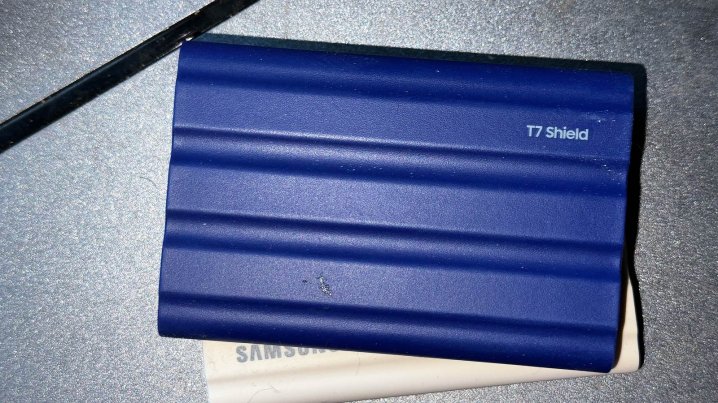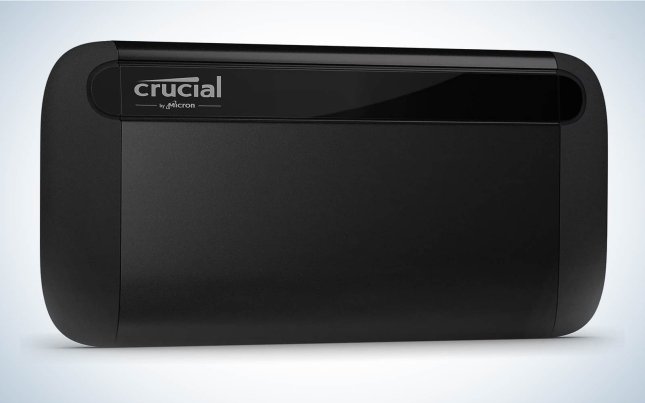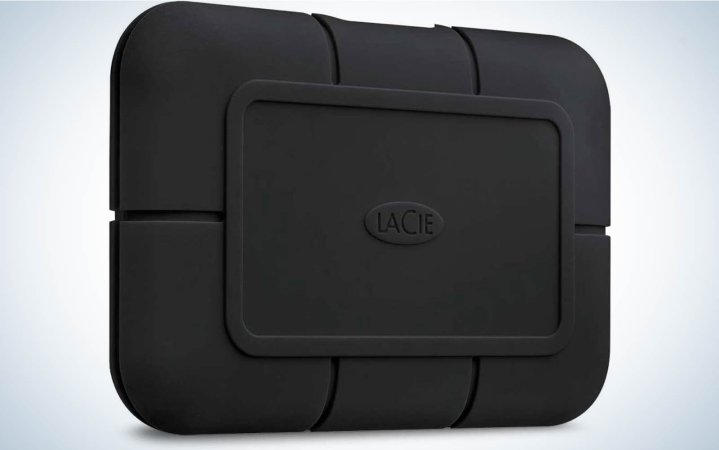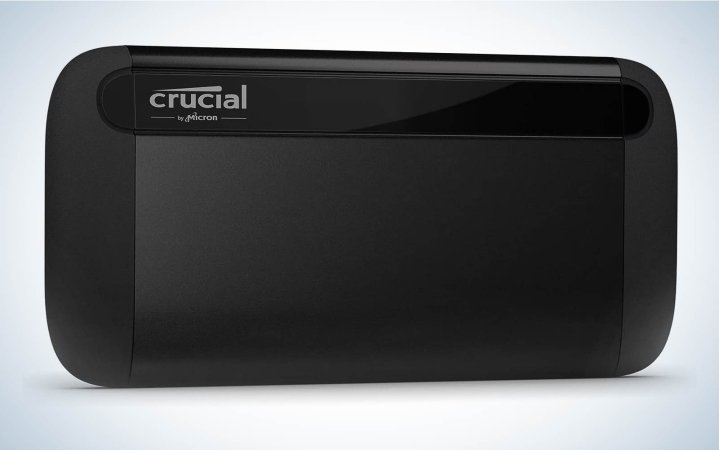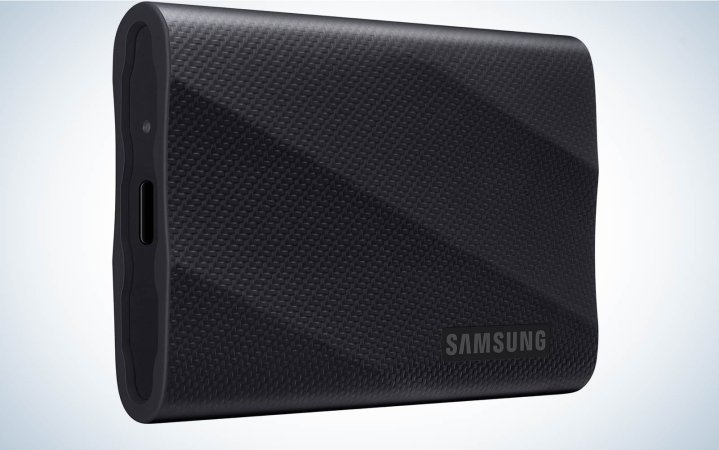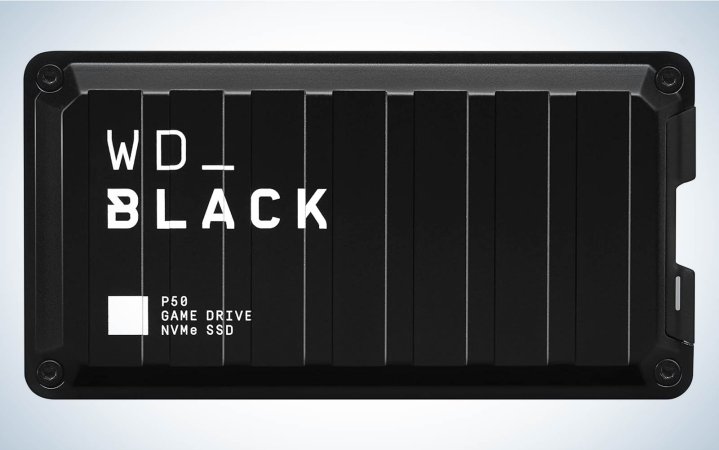We may earn revenue from the products available on this page and participate in affiliate programs. Learn more ›
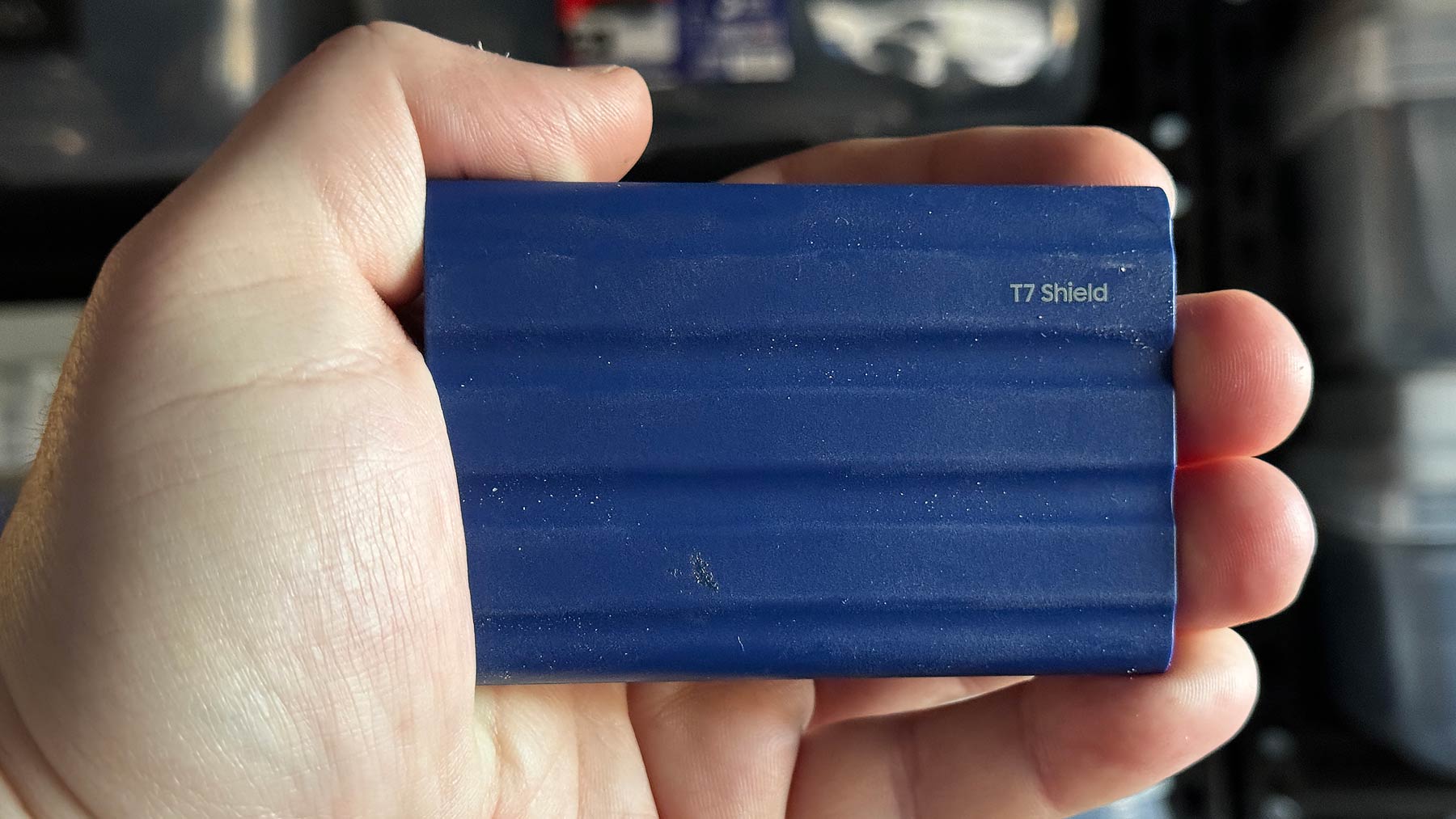
Portable SSDs (short for solid state drives) hold onto large portions of your digital data to keep your computer’s internal drive clean and tidy. These pint-sized SSDs typically offer faster transfers, longer lifespans, and smaller form factors than their traditional hard drive counterparts. As price-per-gigabyte has dropped in recent years, these devices have become more accessible to casual users. That’s great news for photographers, video shooters, and anyone else who wants to carry a lot of digital stuff with them at all times. We’ve rounded up the best portable SSDs for every type of user.
- Best overall: SAMSUNG T7 Shield
- Best splurge: LaCie Rugged SSD Pro Solid State Drive
- Best budget: Crucial X8 Portable SSD
- Best for speed: SAMSUNG T9 Portable SSD
- Best for gamers: Western Digital P50 Game Drive SSD
How we chose the best portable SSDs
As a part-time professional photographer and increasingly less crappy video maker, I regularly rely on portable SSDs to hold the high-res photos and video on which I’m working. I’ve used models from just about every brand and generation. While I have my personal favorites, I realize everyone has different needs. This list emphasizes models that fit specific user needs, such as gamers, high-end pros, and typical users. Most of the options on this list offer some kind of ruggedization because device failure sometimes means data loss, and that’s very bad. It’s worth spending extra upfront to get something burly. Ultimately, this list results from personal experience, editorial reviews, user feedback, spec comparisons, and brand reputation.
You’ll notice that SanDisk’s portable SSDs aren’t on this list at the moment. The company had some data loss issues with its popular models, and we haven’t had time to test the new ones thoroughly yet. The company claims the problems have been solved, and it seems as though that’s the case, but we’re reserving judgment for a while to make sure.
The best portable SSDs: Reviews & Recommendations
While it’s tempting to just go grab the fastest device with the most capacity, that’s probably not the best bet for most people. Here are some specific suggestions for different types of users. We recommend checking out all of the options before purchasing because features and uses often overlap.
Best overall: SAMSUNG T7 Shield
Pros
- Suitably fast transfer speeds
- IP65 ruggedization for solid protection
- Easy to fit in a small pocket
- Comes with both USB-C and USB-A cables in the box
- Color options are attractive without looking flashy
Cons
- Cable is a little short
- USB-C connection can come loose if jostled
Specs
- Capacity: 1TB, 2TB, and 4TB
- Sequential read/write speeds: 1,000/1,050 MB/s
- Size: 3.39 x 2.24 x 0.49 inches
- Weight: 3.5 ounces
This is the storage device that I use in my everyday work life. I’ve had several of these over the past year or so and I find that they offer the best mix of ruggedness, performance, price, and portability.
Each little device is IP65 certified, which means it can withstand serious moisture, dust, and impacts. It’s also crush-proof, which can be important if you ever lug a drive around in a heavy bag or even your pocket. The USB 3.2 Gen 2 connection offers sequential read and write speeds up to 1,000 MB/s and 1,050 MB/s, respectively. That’s plenty fast for editing high-res video footage directly off the device, as long as your computer has the correct connectivity. I currently use the MacBook Pro M3 Max (and we definitely recommend these as external drives for Mac), but most current-gen computers above $500 should be compatible.
The drive doesn’t have an integrated connector. Instead, it has a USB-C port on the edge. The box includes both a USB-C and USB-A cable, so it’s ready to attach to basically any computer immediately. The USB on the device itself can come loose if you move the drive around a lot, but I never had it become an issue during real-world usage.
It’s not the cheapest option per-gigabyte when it comes to storage, but it’s also not as expensive as some of the other rugged options available at the moment. These also often go on pretty steep discounts when shopping holidays such as Black Friday roll around, so keep an eye on the price as you go.
Best splurge: LaCie Rugged SSD Pro Solid State Drive
Pros
- Screaming fast read/write speeds thanks to the Seagate NVMe SSD inside
- IP67 ruggedized
- Five-year warranty
- Pro aesthetics
- Data recovery service included in warranty
Cons
- Wildly expensive
Specs
- Capacity: 1TB, 2TB, or 4TB
- Sequential read/write speeds: 2800MB/s
- Size: 1.44 x 3.52 x 5.71 inches
- Weight: 3.5 ounces
If you’re familiar with LaCie drives, you’re probably used to seeing them sporting bright orange rubber bumpers around them. This device offers a similar form factor but has an all-black rubberized exterior instead. The case is IP67 rated, so it’s water-resistant, dust-resistant, and rugged enough to endure a drop from above your head. It’s even crush-resistant enough that driving a car over it likely wouldn’t break it.
It’s what’s inside that makes this drive so fast (and expensive), however. The Seagate NVMe SSD drive inside can read and write speeds up to 2,800 MB/s. Of course, you’ll need a ThunderBolt 3-equipped computer that can handle that kind of transfer speed, but it’s nice to know the drive will never be your bottleneck.
If you’re working on 8K footage, slow-motion, or other high-end cinematic file types, the extra speed might be useful. If you’re just doing basic creative work, a slower drive likely won’t trip you up much, if at all. Still, if you’re a professional, the investment may be worth it for the five-year warranty, which includes data recovery if something happens.
Best budget: Crucial X8 Portable SSD
Pros
- Very cheap
- Relatively fast compared to HDDs at its price point
- Pocketable
- Somewhat rugged
Cons
- No IP ruggedness rating like some other pricier models
- Speed isn’t as consistent as others
Specs
- Capacity: 1TB, 2TB, and 4TB
- Sequential read/write speeds: 1,050 MB/s
- Size: 4.33 x 0.45 x 2.09 inches
- Weight: 3.5 ounces
You can still get speedy storage on a tighter budget. This pocket-friendly drive manages a very solid 1,050 MB/s both read and write speeds over a USB-C connection. If you’re looking for the best value, the 1TB model is just $60, and the top-end 4TB model is just $199. That includes a USB-C cable in the box.
The drive itself is relatively unremarkable. You don’t get much in the way of security features, but not everyone really needs that. The case is somewhat ruggedized, but it lacks the formal IP rating you’ll get with a more expensive model. Ultimately, this is a great option for people who don’t need top-end performance or simply want a cheaper backup to their backup for extra redundancy. If you’re thinking that sounds neurotic, you’re right and I’m totally guilty of it.
Best for speed: SAMSUNG T9 Portable SSD
Pros
- Fast read and write speeds for cheaper than NVMe models
- Very understated design fits easily in a pocket
- Box includes two cables, USB-C and USB-A
- Drop-tested from just under 10 feet
Cons
- Not water-resistant
- More expensive than budget-oriented drives
Specs
- Capacity: 1TB, 2TB, and 4TB
- Sequential read/write speeds: 1,950MB/s and 2,000 MB/s
- Size: 3.5 x 2.4 x 0.6 inches
- Weight: 4.3 ounces
If you don’t mind trading toughness for speed, this is an excellent storage device from Samsung. It reads and writes at up to 1,950 MB/s and 2,000 MB/s, respectively, which means it can handle 4K video at 60 fps, including Apple ProRes from the latest iPhones.
It has a design similar to the older model Samsung T-series drives, which were also pretty excellent. The T9 isn’t water-resistant, but it is drop-resistant from just under 10 feet, so if you’re just lugging files and footage between home, the office, and a studio, toughness shouldn’t be an issue.
Best for gamers: Western Digital P50 Game Drive SSD
Pros
- Super-fast NVMe memory helps reduce load times and lag
- Aesthetic appearance
- Higher capacities store tons of games
- Compatible with the Xbox Series X, PS5, and PCs
Cons
- Expensive per gigabyte
Specs
- Capacity: 1TB, 2TB, and 4TB
- Sequential read/write speeds: 2,000 MB/s
- Size: 4.65 x 2.44 x 0.55 inches
- Weight: 4.1 ounces
This SSD takes aim squarely at the gaming crowd. Modern consoles and gaming PCs demand wide-open bandwidth, which this small device provides. Tucked inside a rugged aluminum case, this NVMe SSD can plug-and-play with the popular current-gen consoles and gaming PCs and laptops alike. You likely won’t notice any performance differences between playing off the drive and keeping games on the console’s built-in storage. Not every drive will work with consoles, so it’s nice to know this one is easy to install and set up without having to worry about compatibility.
Things to consider when shopping for the best portable SSDs
Ruggedization
These are portable devices, and many terrible things can happen to a piece of electronics in the depth of a backpack. Only a few of these options come with a full-on IP rating, typically suggesting moisture, dust, and pressure resistance. Some drives are hardened against falls but can’t resist the elements. Be sure to check out the specs and consider where you’re taking the drive before committing.
Capacity
I have never once been sorry that I bought the bigger version of a digital storage product. The extra space will make the device cost more upfront, but it will also likely be useful for longer with more storage space. Of course, it pays to know your own habits. If you’re just moving around Word files and a few photos, don’t waste money on a big 4TB storage device.
Transfer speeds
If you’re working with high-res images or videos, you want as much speed as you can afford. Common devices top out around 1,000 MB/s, which is fine for most photo and video editing unless you’re pushing it. You’ll want something faster if you’re working with very high-def content. The same goes for a drive you want to work with a video game console. Games can hog up just as much bandwidth as creative apps, sometimes more.
Security features
Some storage devices come with built-in security features like password locking, encryption, and even data recovery in case of a loss. These are typically some of the first things to go when you get into cheaper drives.
FAQs
SSDs don’t really have moving parts like hard disk drives, which typically translates into more longevity. But SSDs are rated for read/write cycles, so the more you use them, the more they’ll break down. Typically, however, SSDs are very reliable and will last you years before they need replacing.
The fastest storage on this list transfers files at 2,800MB/s. That’s plenty fast for editing UHD and even slow-motion video right off the device.
Using an internal SSD as an external drive is possible if you have an enclosure with an adapter. As prices have come down, though, you’re likely better off just getting a dedicated device that doesn’t have a DIY element.
Final thoughts on the best portable SSDs
- Best overall: SAMSUNG T7 Shield
- Best splurge: LaCie Rugged SSD Pro Solid State Drive
- Best budget: Crucial X8 Portable SSD
- Best for speed: SAMSUNG T9 Portable SSD
- Best for gamers: Western Digital P50 Game Drive SSD
A portable SSD could be handy even if you’re not a professional content creator or avid gamer. It’s great to lug around files that are too big to keep in the cloud or on your computer’s hard drive. It’s also a great way to back up your stuff on-the-go thanks to super-fast transfer speeds. If you’re currently lugging around an external drive with a spinning HDD inside, it’s time to upgrade to one of the best portable SSDs.
Thanks for reaching out. I’ve gotten a pretty wild response to this call out and it’s been amazing so it’s going to take me a while to sort through all of these awesome new (to me) writers. We’re on a rolling assignment schedule that happens quarterly, so I’m going to keep everyone in our database with their strengths and areas of expertise and reach out if we have a fit. Thanks again for taking the time and it’s great to meet you!
